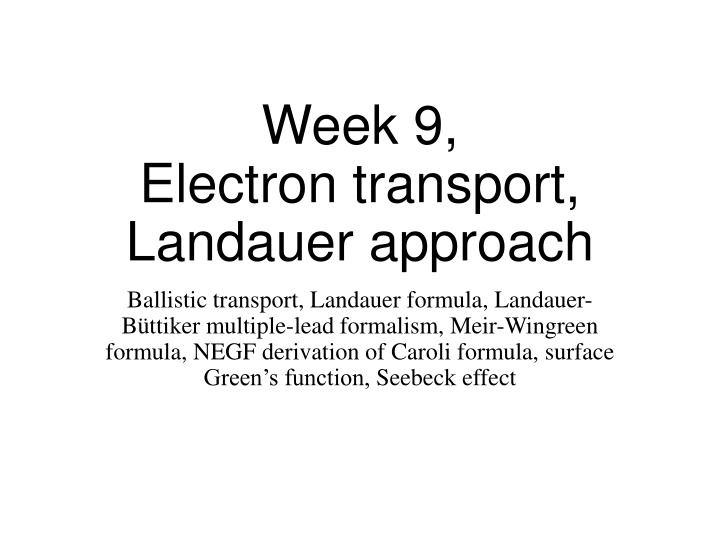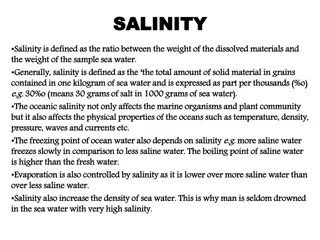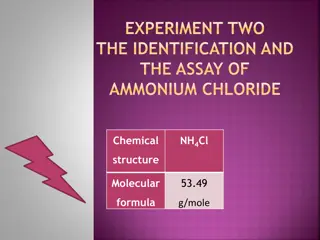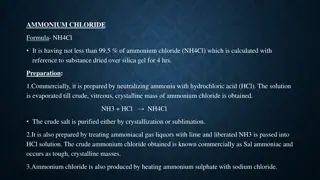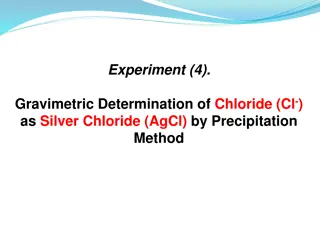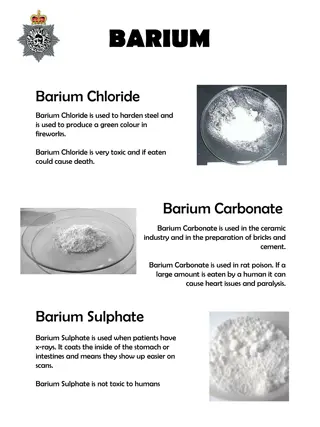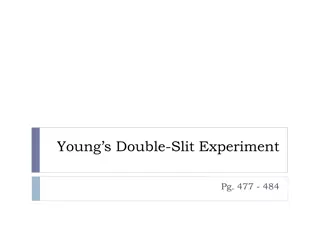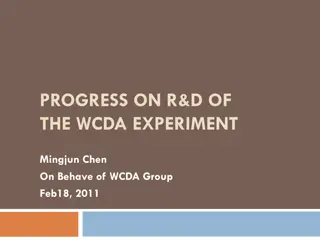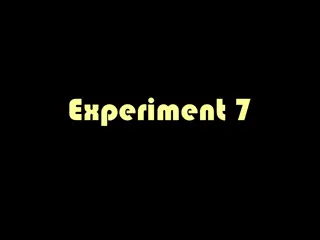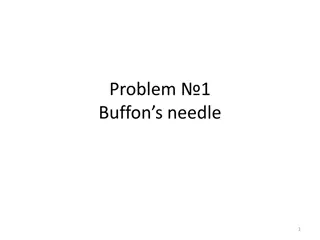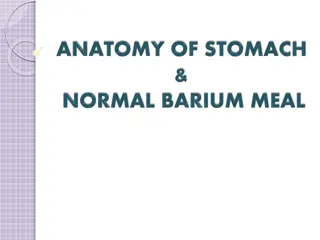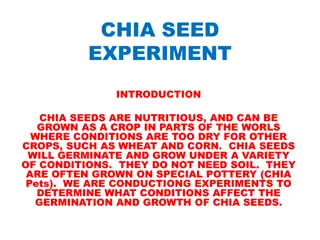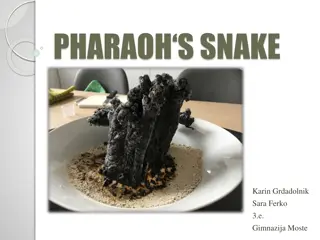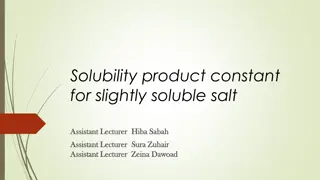Preparation of Barium Chloride Di-Hydrate: Experiment and Uses
Preparation of barium chloride di-hydrate (BaCl2.2H2O) is explored in this practical, along with its uses in the laboratory and industry. The procedure involves reacting barium carbonate with hydrochloric acid to obtain hydrated barium chloride crystals.
Download Presentation

Please find below an Image/Link to download the presentation.
The content on the website is provided AS IS for your information and personal use only. It may not be sold, licensed, or shared on other websites without obtaining consent from the author.If you encounter any issues during the download, it is possible that the publisher has removed the file from their server.
You are allowed to download the files provided on this website for personal or commercial use, subject to the condition that they are used lawfully. All files are the property of their respective owners.
The content on the website is provided AS IS for your information and personal use only. It may not be sold, licensed, or shared on other websites without obtaining consent from the author.
E N D
Presentation Transcript
Week 9, Electron transport, Landauer approach Ballistic transport, Landauer formula, Landauer- B ttiker multiple-lead formalism, Meir-Wingreen formula, NEGF derivation of Caroli formula, surface Green s function, Seebeck effect
1D chain transport ?? ?? ?? open boundary condition k 2? k ? ? ? ?? ? ? 2? -2 -1 0 1 2 3 N-1 NN+1 . ?? 3 j 2 ?? periodic boundary condition k 1 ?? N N-1
1D ballistic charge transport 1 1 ( ) = ( ) ( ) ( ) ( ) electron charge is I e v f e v f e L k L k k R k Na Na 0 0 k k 1 2 Na ( ) = = ( ) ( ) ( ) e v f f k k L k R k Na 0 k / a dk ( ) = = = ( ) ( ) ( ) ( ) k k e v f f dE d k v dk k L k R k k 2 ( ) 0 + 2 t dE e ( ) ( ) = = ( ) ( ) ( ) E ( ) ( ) ( ) E e f E f dE T E f E f L R L R 2 h 2 t 2 e e h ( ) ( ) = = (at low temperature) ( ) T T V V e V L R L R h = 1 (number of tran smission mode, transmission efficient) T
Fermi distribution f at 300 K kBT is 26 meV ? 0 1 ??? ? ? 1 = ( ) f E + ( )/( ) E k T 1 e B
Resonant tunneling in quantum dot ? ? Left lead ?? Right lead ?? + ( ) e ( ) = ( ) ( ) I f f L R L L R L R ( ) ( ) 1 = = r a r r L r R , i G E H c
Multiple-leads, Landauer- B ttiker/Caroli formulas lead 1 = r r G E H c Scattering region lead ?? lead + e ( ) = ( ) E ( ) E ( ) E I dE T f f h ( ) ( ) ( ) = = = r a a r r a ( ) E Tr , , T G G G G i
Ballistic transport model setup ??? R C L L C R 0 L H C V R V H V L LC ( ) ( ) = = = , , H V H V V V V CL C CR LC CL RC CR 0 RC R 1 c c c c c c 2 c L = c = = = , , , , L C R c H c H c C C N c c R C ( ) = = + + + + + L R h.c. H c Hc H H H c V c c V c L C R LC C RC C
Definition of electric current out of left lead = = = c c ,1 L ( ) ,2 L = L j L j c c L L c c L L L L N , , , , , N c c c c c , , ,1 ,2 , L L L j c , L N L dN dt e i = = = = , [ , ] , [ , ] I e N H c c c c c c c c L L L = + + + + + + = + , , , N H N H H H H H H H N H H L L L C R LC CL RC CR L LC CL = L C c V c c V c LC C CL L e i e i = + = = = jk jk L L j C k c c c.c. 2Re 2 Re e ( 0) I c V c V V G t , , , L LC C LC LC Ck Lj jk jk dE V G V G 2 ReTr e = = (0) 2 Re e Tr ( ) E LC CL LC CL 2
Determine the GCLGreens function on contour time ( , ') ( , ') = ( , ') i G HG I 0 0 I 0 0 I G G G G G G G G G H V V H V I LL LC LR L LC L = = = , 0 0 G H V H I CL CC CR CL C CR C 0 0 RL RC RR RC R R ( , ') ( , ') = ( , '), = , , L C R i g H g I Solve in terms of and sm all , we get G G g CL CC ( ) ( , ') ( , ') ( , '') + ( , '') ( '', ') = ( , ') '' i G H G d G I CC C CC L R CC C ( , ') = ( , '') ( '', '), ( , ') = ( , ') = '' , , G d G V g V g V L R CL CC CL L C C
From differential equation to integral equation the Dyson equation = ( , ') = ( , ') i H G I i h g I 0 0 0 0 0 H V L LC = h V + = = = , 0 0 , 0 , self energy H h H V V V V g V C CL CR C C 0 0 0 H C R RC = + Check that i.e., G g gVG L L 0 0 0 0 0 0 0 0 G G G G G G G G G g g V G G G G G G G G G LL LC LR LC LL LC LR = + C C 0 0 0 0 0 g g V V CL CC CR CL CR CL CC CR R R 0 0 0 0 g g V RL RC RR RC RL RC RR = = = + = = = L L L , , + G g g V G G g V G LL LC CL g V G LC LC + CC + C C C C C , , G g V G G g g V G g V G CL CL LL CR RL CC CL LC CR RC R R , G g V G G g V G RL RC CL RC RC CC
Recall the consequence of Dyson equation on contour = g G + (contour time version) G g (apply Langreth theorem) = + = , , r r r r r r a , (real time/energy space) G g g G G G G (Keldysh equation)
Apply Langreth rule in E space = + r CC a L ( ) E ( ) E V g ( ) E ( ) E V g ( ) E G G G CL CL L CC CL = r a put into the current expression: G G G ) G ( ) ( = = r a , G G G G dE V G = + Tr ( ) E c.c. I e L LC CL 2 dE V G = + + r CC a L Tr ( ) E V g ( ) E ( ) E V g ( ) E c.c. e G LC CL L CC CL 2 dE = + ( ) h.c. E + r a L Tr ( ) ( ) E ( ) e G E G E L 2 dE ( ) (Meir-Wingreen) E = Tr ( ) ( ) E ( ) e G E G E L L 2 e h ( ) = r a Tr (Laudauer/Caroli) dE G G f f R L L R
From Meir-Wingreen to Landauer = + = + r a r a ( ) , ( ) G G G G G G L R L R ( ) ( ) = = = r a , 1 , if i f i = r a = + + r a r a ( ) ( ) G G G G G G L L L R L L R L = r a ( ) f f G G L R R L
Example, 1D chain with a single site in center; step 1, determine surface Green s function gL 0 0 1 t 2 ... 0 t 0 ( ) = + i = r L , ( ) H E I H g I 1 2 0 0 t L L 0 0 t t 0 t + ( ) 1, ( ) j j tg i tg + + + 0 + i + = = 0 E g tg j = 0,0 E 1,0 g = 1, 2, 0, j 1,0 + 1,0 ,0 j 1 = + + i + = + i A tA + = j Try , ( ) 0, ( ) 1 j g A t E t E ,0 = = , 1 A g 0,0 t
Example, 1D chain with a single site in center, step 2, determine lead self energy and Gcc = = 0 1 0 2 ... 0 = = r L L r R V V g V t CL CL LC 1 t 1 ( ) = = = = + + i + = r L a L 0, 2 Im t , ( ) 0 H i t E t C L R 1 1 ( ) 1 = + i = = r CC r L r R ( ) G E I H C + i + 1 2 E t t ?(?) 1 ( ) ( ) 2 = = r a ( ) T E Tr 2 Im t G G 1 R L 2 1 2 t 1, if | | 2 0, otherwise E t = E 2? +2?
Energy transmitted by electron dH dt dE ( ) (Meir-Wingreen form) E = = Tr ( ) ( ) E ( ) J E G E G E L L L L 2 dEE ( ) = r a Tr (Laudauer/Caroli form) G G f f R L L R 2 1 1 = = = , , , f L R + ( ) E 1 e k T B
Coupled charge & heat transport by electron and Seebeck effect = = + ( ( / )) Q J dN dt J I L L L L L L e Linear response (small voltage and temperatue differences between leads) : conductance L R L R I G V V SG T T Q G V K T T + : thermal conductance Onsager relation: : Peltier coefficient Seebeck coefficient V S T ( ) V ( ) + G ( ) ( ) K L R L R = TS = (at 0 electric current)
